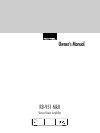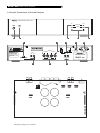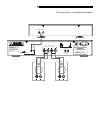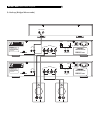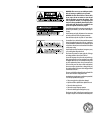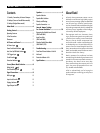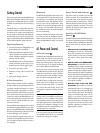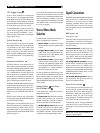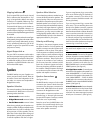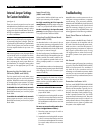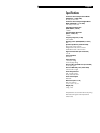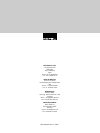
10
RB-951 MkII Stereo Power Amplifier
Internal Jumper Settings
for Custom Installation
(see figure 1)
There are internal jumpers that can be used
to disable the front panel level controls, to select
one of two input sensitivity settings, and to
engage the special Parallel Mono mode for
driving low impedance speaker combinations
in custom installations.
WARNING
: Removing the top cover of the am-
plifier to access the jumpers may expose you
to potentially dangerous voltages. These set-
tings should only be made by a qualified tech-
nician. The AC power cord must be removed
from the amplifier before the top cover is re-
moved.
After removing the top cover, the jumper blocks
can be found on the circuit board as shown
in Figure 1. Each jumper block has a printed
identification number. The function, ID num-
bers, and settings for each jumper block are
provided below. To change the setting, place
the jumper on the appropriate pins as indi-
cated.
Bypassing the Variable Level
Controls (S603 and S604)
The front panel Level Controls allow you to
adjust the input gain for each channel of the
amplifier. These level controls can by bypassed
by changing the jumper position on jumper
blocks S603 (for CH 1) and S604 (for CH2).
To disable the variable level controls:
place a jumper across pins 2 and 3 on jumper
block S603 and across pins 1 and 2 on jumper
block S604.
To enable the variable level controls:
place a jumper across pins 1 and 2 on jumper
block S603 and across pins 2 and 3 on jumper
block S604.
Input Sensitivity
(S605 and S606)
Jumper blocks S605 and S606 are used to
set the input sensitivity of the amplifier.
For high sensitivity (0.775v input for
rated power): place the jumpers across pins
1 and 2 on jumper blocks S605 and S606.
For low sensitivity (1.5v input for rated
power): place the jumpers across pins 2 and
3 on jumper blocks S605 and S606.
Selecting Parallel Mono Mode
(S602 and P1/P3)
As described earlier in this manual, the two
most common operating configurations for the
RB-951
MkII (Stereo mode and Bridged Mono
mode) are selectable with a back panel switch
and require no internal changes.
The third configuration, Parallel Mono mode,
allows both channels of the amplifier to be com-
bined in parallel. This mode is useful for driv-
ing a low impedance speaker load such as
driving multiple speakers in a custom instal-
lation.
This Parallel Mono mode can be selected only
by setting internal jumpers (jumper block S602)
and changing a buss wire connection (con-
nectors P1and P2).
NOTE
: it is essential that Parallel Mono mode
not be engaged at the same time as Stereo
mode. This will blow the internal rail fuses.
Make sure that you follow all of the instruc-
tions below carefully.
To convert to Parallel Mono mode:
1. Place the jumper across pins 1 and 2 on
jumper block S602.
2. Locate the buss wire linking the P2 connector
to the P3 connector. Remove the wire from
P3 and move it to the adjacent P1 connector.
For Parallel Mono mode, the buss wire must
link P2 to P1.
To return to normal configuration (Ste-
reo or Bridged Mono modes):
1. Place the jumper across pins 2 and 3 on
jumper block S602.
2. Locate the buss wire linking the P2 connector
to the P1 connector. Remove the wire from
P1 and move it to the adjacent P3 connector.
For normal mode, the buss wire must link
P2 to P3.
Troubleshooting
Most difficulties in audio systems are the re-
sult of poor or wrong connections, or improper
control settings. If you encounter problems,
isolate the area of the difficulty, check the control
settings, determine the cause of the fault and
make the necessary changes. If you are un-
able to get sound from the RB-951
MkII, refer
to the suggestions for the following conditions:
Front Panel Power Indicator Is
Not Lit
No main power to the RB-951MkII. Check AC
power connections at the amplifier and the
AC outlet. Check the front panel power switch.
Make sure that it is set to the ON position. If
using signal sensing auto power-on, make sure
that a signal is present at the inputs. If using
12V trigger power-on, make sure that a trig-
ger signal is present at rear panel screw ter-
minals.
No Sound
If the amp is getting AC power, but is producing
no sound, check the PROTECTION INDICA-
TORS on the front panel. If lit, see below. If
not, check all of your connections and con-
trol settings on associated components. Make
sure that your input connections and speaker
connections match your selected stereo/mono
configuration.
Protection Indicator Is Lit
The front panel PROTECTION INDICATORS
light when the RB-951
MkII protection circuits
have shut off the amplifier. Typically, this oc-
curs only when the ventilation openings are
blocked, when there is faulty speaker wiring,
or after a period of extreme use. Turn off the
system and wait for the amp to cool. Then push
the front panel power switch in and out to re-
set the protection devices. If the problem is not
corrected or reoccurs, there is a problem with
the system or the amplifier itself.



